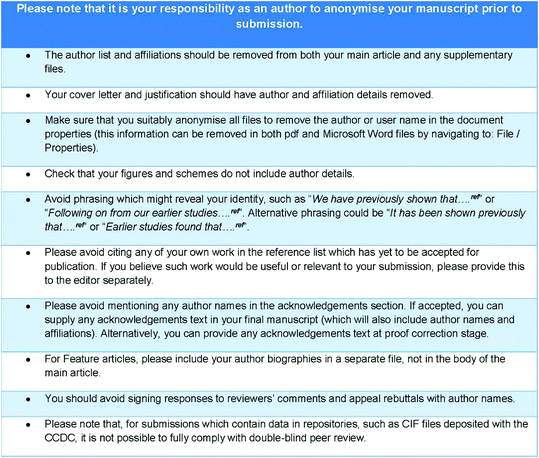ChemComm trials double-blind peer review option
We are pleased to let our community know that from July 2017, for a period of 12 months, we will be offering our authors a choice on how their manuscripts are peer reviewed on ChemComm. Authors can choose either the current single-blind peer review model – where reviewers remain anonymous but author names and affiliations are known to reviewers, or double-blind peer review – where the identities of authors and reviewers are concealed from each other.The choice of which peer review model should be used for each manuscript will be completely up to the authors. However, authors who opt for the double-blind process will need to anonymise their manuscript before submission, avoiding mention of any information that might give away their identity. Authors who choose this option will be responsible for ensuring their submission is anonymised; Fig. 1 shows the checklist we have prepared to help authors with anonymising their manuscript.
 | ||
| Fig. 1 Checklist for preparing your manuscript for submission to ChemComm under the double-blind peer review option. | ||
Why a double-blind trial?
ChemComm has always used the traditional, single-blind peer review model favoured by most scientific journals, and we continue to trust in the effectiveness of this system.However, peer review relies on humans and it is well known that it is not a perfect process; therefore it is only natural that we should want to improve it as much as possible. We have listened to feedback from members of the chemical science community and we have seen the growing interest in alternative peer review models such as double-blind peer review. In addition to the more traditional single-blind peer review, double-blind peer review is now being used in different disciplines across scholarly publishing with Nature and Nature research journals announcing their plan to offer a double-blind peer review option across their journals.1 The Institute of Physics (IOP) are also trialling double-blind peer review on two of their journals during 2017. Proponents of double-blind review suggest that it can reduce the impact of biases, both obvious and subtle, conscious or otherwise, on peer review. These biases could be based on gender, ethnicity, author affiliation, and so on. However, the evidence for the effectiveness of double-blind peer review in reducing bias and increasing quality in the review process is not clear cut and so we want to gather our own evidence.2 By offering ChemComm authors a choice, we hope to gain a greater understanding about whether there is a demand for double-blind review from our authors and, where possible, to measure any differences in the effectiveness of the peer review between the two approaches.
Why ChemComm?
We believe that ChemComm is the best journal to carry out such a trial because it is a high-volume journal with broad subject and regional coverage, and has high visibility across the chemistry community. This means we will have the best chance of gathering sufficient evidence on which to base a decision and that evidence should be broadly applicable across sub-disciplines and geographic regions.How will it work?
We will be running a trial for 12-months where both single- and double-blind peer review options will be available for submissions to ChemComm. These options will be available from the 3rd of July. Authors need only select the double-blind option upon submission to choose this process. Reviewers for ChemComm should also be aware that they may be invited to review a manuscript that has been anonymised and all communication regarding double-blind manuscripts will omit author and affiliation details. It should be noted that the Editors will not be blinded – they will still know the identity of both authors and reviewers throughout the peer review process.Any authors that submit to ChemComm during this time as well as any reviewers submitting a review will be asked to complete a short survey about their experience. As authors and reviewers, please do use the survey to provide us with your feedback – this is an important aspect of our evidence gathering and will help us better understand how the trial has worked. After the trial, we will share the results with the community and use the evidence gathered to make a decision about using double-blind review in future.
For more information about how to take part, please see our guidelines for authors and reviewers.
Véronique Gouverneur, Chair, ChemComm Editorial Board.
Philippa Hughes, Executive Editor, ChemComm.
References
- Nature, 2015, 518, 274 DOI:10.1038/518274b.
- B. O'Hara, Peer Review Week: Should we use double-blind peer review? The evidence…, (Methods.blog, the official blog of Methods in Ecology and Evolution) and references therein, 22 Sept 2016, available at: http://https://methodsblog.wordpress.com/2016/09/22/peer-review-week-should-we-use-double-blind-peer-review-the-evidence/.
| This journal is © The Royal Society of Chemistry 2017 |
